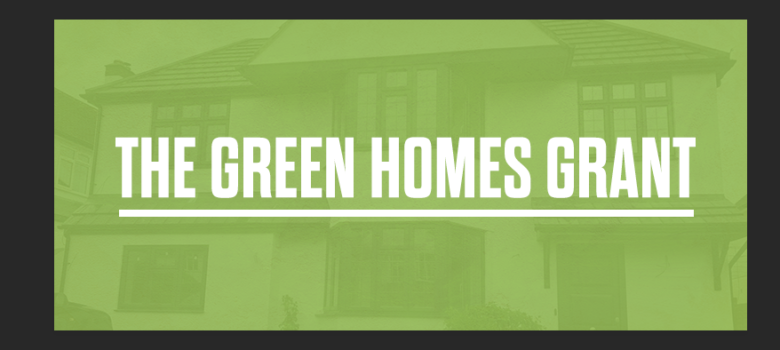
A new Government scheme launching in September will help homeowners in England improve the energy efficiency of their properties via a £5,000 grant. The grant can be used for a whole range of energy saving improvements including double-glazing, loft insulation, solid wall insulation and floor insulation.
Improving the thermal efficiency of the envelope of the property (floor, walls and roof) in our opinion is the best way to help lower homeowner’s energy bills and also reach the Governments ambitious energy targets.
In total, the Chancellor Rishi Sunak has put aside £2 billion for the Green Homes Grant scheme, meaning a minimum of 400,000 homeowners in England should benefit.
It is expected that everyone will be able to apply for this grant – it will not be means tested.
It is worth noting that much like the Green Deal Home Improvement fund grant that was launched several years ago, the Green Homes Grant will require a contribution from the homeowner (in most cases) – the current thinking is that approximately two-thirds of the cost of the energy efficiency works will be covered by the grant with the homeowner expected to pick up the other third.
Green Home Grant Example 1: Cavity Wall Insulation
Cavity wall insulation costs approximately £11 per m2, so for a mid-terrace house that is 5 metres across there is approximately 25m2 of wall on the front and the back – so in total 50m2.
Total Wall Area (50m2) x 11 per m2 = £550 total cost.
2 / 3rd Government contribution – £366.66
1 / 3rd Household contribution – £183.33
Green Home Grant Example 2: Double Glazing
A new double-glazing window costs approximately £600 so in a detached house with 13 windows, the total cost of getting the glazing replaced would be £7,800.
2 / 3rd Government contribution – £5,200
1 / 3rd Household contribution – £2,600
However, the maximum homeowner grant is £5000, so the homeowner would actually have to pay £2,800.
Green Home Grant Example 3: Solid Wall insulation
Our friends at EWI Store have helped us with the costings on a typical semi detached house. The cost of installing 90mm of EPS is approximately £90 per m2, so on a semi detached house could be anywhere from £10,000 to £14,000 depending on the length of the flank wall.
In this case you would get the full £5,000 grant and need to top up the remaining £5,000 – £9,000 for the rest of the works. This being the case, it maybe an option just to do a particular problem wall e.g. a long cold flank wall for example.
What about those who can’t afford to make the ‘Customer Contribution’?
The scheme is open to all, but it is thought that Low Income households will be able to claim £10,000 under the scheme and those households will not be required to make any contribution. However there unfortunately will no doubt be some properties who ‘fall through the gap’ and will be unable to afford the contrition if they are not considered to live in low income households.
What energy saving improvements does the Green Homes Grant cover?
As mentioned previously, the Government want to make insulating the envelope of the home a priority, so we expect cavity wall insulation, external wall insulation, loft insulation double glazing and floor insulation to be the priority.
We would be surprised if the grant covered ‘topping up’ of existing insulation measures – so for example if the householder already has 170mm of loft insulation, it seems unlikely the Government will provide a grant for this to be topped up to 300mm as the incremental energy saving gains will be minimal.
Having said that, the Government is not just trying to improve the energy efficiency of England’s housing stock, it is also trying to promote job growth in the Green Economy following the COVID-19 pandemic, so potentially some of the marginal upgrades may actually make the cut, for example just replacing 1 or 2 windows in the home.
While the Government are keen to improve the efficiency of the envelope of homes, the way the announcement was worded suggests that improvements to heating systems (e.g. boilers) will not be included. In our opinion, this makes sense as replacing a boiler typically only produces minimal energy savings especially if the existing boiler has been installed within the last 15 years.
How do you get the Green Homes Grant?
Unfortunately, the Government are yet to reveal exactly how the scheme will run, however we think it is a fair bet they will use the previous Green Deal Home Improvement fund grant as a blueprint. For that scheme, the homeowner had to apply for the voucher via a Government portal and at the same time had to select their approved installer and we think this will be the same process this time round.
In terms of the approved installers, under the previous scheme they had to be PAS2030 certified. PAS2030 was a framework that the installers needed to adhere to ensure quality of works. It included things like a site specific methodology and health and safety requirements. PAS2030 has since been superseded by the PAS2035 – but the framework and ideas behind it are pretty similar – it is hoped that installer companies who have this accreditation will carry out the works to a high level.
As more information becomes available on the exact mechanism of the scheme we will update this blog.
Our thoughts on the Green Homes Grant
We started the GreenAge in 2011 and over the years there have been lots of grant schemes that have come and gone. It seems the 2020 Green Homes Grant is going to be based on the GDHIF scheme that has gone before it.
While at the time the GDHIF grant was welcomed, it did create a couple of issues:
- Companies with little actual install experience carry out the works – so while PAS2035 is a framework that should encourage good standard of works, it unfortunately can encourage quite the opposite. Seemingly whenever a grant is announced a raft of new companies appear and produce a pretty website and quickly become accredited with the PAS2035 scheme. This means they can create a nice pipeline of work for 12 months or so – however many of these companies only plan to operate while the grant is active i.e. take your money (and the Government’s and then run) – so please check to ensure the company you are looking to use has been operating in the industry for at least 12 months before considering using them. A simple search on Companies House will give you this information.
- The companies operating within the scheme know you are getting a grant to cover a substantial part of the works; therefore, may charge more for works under the scheme. We have seen many installers try and attribute these increased costs to ‘more paperwork’ however in reality they know they can charge more and get away with it as overall the homeowner is still getting a better deal when the grant is factored in.
The hope is the Government find a mechanism to weed out the ‘cowboys’ and then this will be a much need shot in the arm for the green energy sector. As we get more information – we will update the blog.













I welcome this scheme. But for the scheme to be up and running for September 2020, very few companies I have contacted seem to know anything about it.
Different articles I have read which state type of work which qualifies also contradicts one another.
I was wondering if the work I am planning would meet the criteria,
Replacing an old felt roof on my conservatory with a new light weight tiled roof.It will be insulated.
Replacing an old set of patio doors with bi-fold doors.
Lastly replacing a draughty front door with a new
thanks for the info
I have heard that under the green homes grant scheme, if you are looking to install external wall insulation you have to use a mineral wool system rather than the much cheaper EPS system? Is this true?
Hi Kev,
We were hearing rumours of that oursevles a while back, but I think these are unfounded. We are now 99% confident getting EPS installed via the green homes grant scheme will be absolutely fine (and obviously cheaper!).
Hi,
I live in a small block of flats with 5 neighbours. I was wondering if we would all be allowed to apply for the green homes grant scheme seperately as I think this would pretty much cover the cost of all the works if my calcs are correct. Will this be possible or can you just get one green homes grant for a house / building. Thank very much for all your help in advance.
Hi Taj,
Yes – you can each individually claim the grant – up to £5k each. But do remember that you need to cover 1/3 of the cost of the works, so if the total cost of the works for all 5 flats comes to £35k for example, then provided it is done equally, then you would each need to cover £5,833 of the works. But you can only claim 2/3s of the cost of the works up to a maximum of £5,000, so you would actually still need to contribute £1,944 of your own money and the rest would be covered by the green home grant.